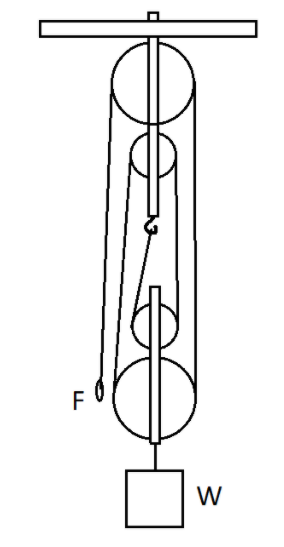
Fig, shows a block and tackle system pulleys used to lift a load. What is the mechanical advantage of the system?

(A) 6
(B) 8
(C) 4
(D) 2
Answer
217.8k+ views
Hint: This could be simply solved by breaking the diagrams into simple free body diagrams of both the blocks. Then apply Newton’s law of motion.
Formula used: Here, we will use the basic formula NLM-2:
${\text{F = ma}}$
Here, ${\text{F}}$ is the force exerted on the block
${\text{m}}$ is the mass of the block
${\text{a}}$ is acceleration of the block
Complete step by step answer:
We already know that the bodies are connected together by rope,
So, both the bodies will have the same acceleration.
As we know that the movable part is known as tackle in which load is always attached and fixed part is known as block, but in this diagram the pulley on which load is applied is connected to tackle pulley hence by observing the configuration we can say four tackle is required for it to support the load.
Then we need to match the correct option.
The correct option is C.
Additional Information: A pulley is a wheel on an axle or shaft that is designed to support movement and change of direction of a taut cable or belt, or transfer of power between the shaft and cable or belt. In the case of a pulley supported by a frame or shell that does not transfer power to a shaft, but is used to guide the cable or exert a force, the supporting shell is called a block, and the pulley may be called a sheave
Note: It should be always kept in mind that we should always draw the FBD of the body before solving any force questions. Also, never forget to assume tension force away from the body wherever there is rope in pulley or block questions. Similarly, spring forces also are a case of springs acting tensile (away) from the body. Also, if the bodies are connected together, they will have the same acceleration.
Formula used: Here, we will use the basic formula NLM-2:
${\text{F = ma}}$
Here, ${\text{F}}$ is the force exerted on the block
${\text{m}}$ is the mass of the block
${\text{a}}$ is acceleration of the block
Complete step by step answer:
We already know that the bodies are connected together by rope,
So, both the bodies will have the same acceleration.
As we know that the movable part is known as tackle in which load is always attached and fixed part is known as block, but in this diagram the pulley on which load is applied is connected to tackle pulley hence by observing the configuration we can say four tackle is required for it to support the load.
Then we need to match the correct option.
The correct option is C.
Additional Information: A pulley is a wheel on an axle or shaft that is designed to support movement and change of direction of a taut cable or belt, or transfer of power between the shaft and cable or belt. In the case of a pulley supported by a frame or shell that does not transfer power to a shaft, but is used to guide the cable or exert a force, the supporting shell is called a block, and the pulley may be called a sheave
Note: It should be always kept in mind that we should always draw the FBD of the body before solving any force questions. Also, never forget to assume tension force away from the body wherever there is rope in pulley or block questions. Similarly, spring forces also are a case of springs acting tensile (away) from the body. Also, if the bodies are connected together, they will have the same acceleration.
Recently Updated Pages
Elastic Collision in Two Dimensions Explained Simply

Elastic Collisions in One Dimension Explained

Electric Field of Infinite Line Charge and Cylinders Explained

Electric Flux and Area Vector Explained Simply

Electric Field of a Charged Spherical Shell Explained

Electricity and Magnetism Explained: Key Concepts & Applications

Trending doubts
JEE Main 2026: Application Form Open, Exam Dates, Syllabus, Eligibility & Question Papers

Derivation of Equation of Trajectory Explained for Students

Hybridisation in Chemistry – Concept, Types & Applications

Understanding the Angle of Deviation in a Prism

Understanding Collisions: Types and Examples for Students

How to Convert a Galvanometer into an Ammeter or Voltmeter

Other Pages
JEE Advanced Marks vs Ranks 2025: Understanding Category-wise Qualifying Marks and Previous Year Cut-offs

Understanding Atomic Structure for Beginners

Ideal and Non-Ideal Solutions Explained for Class 12 Chemistry

Degree of Dissociation: Meaning, Formula, Calculation & Uses

Understanding Electromagnetic Waves and Their Importance

Understanding the Electric Field of a Uniformly Charged Ring




